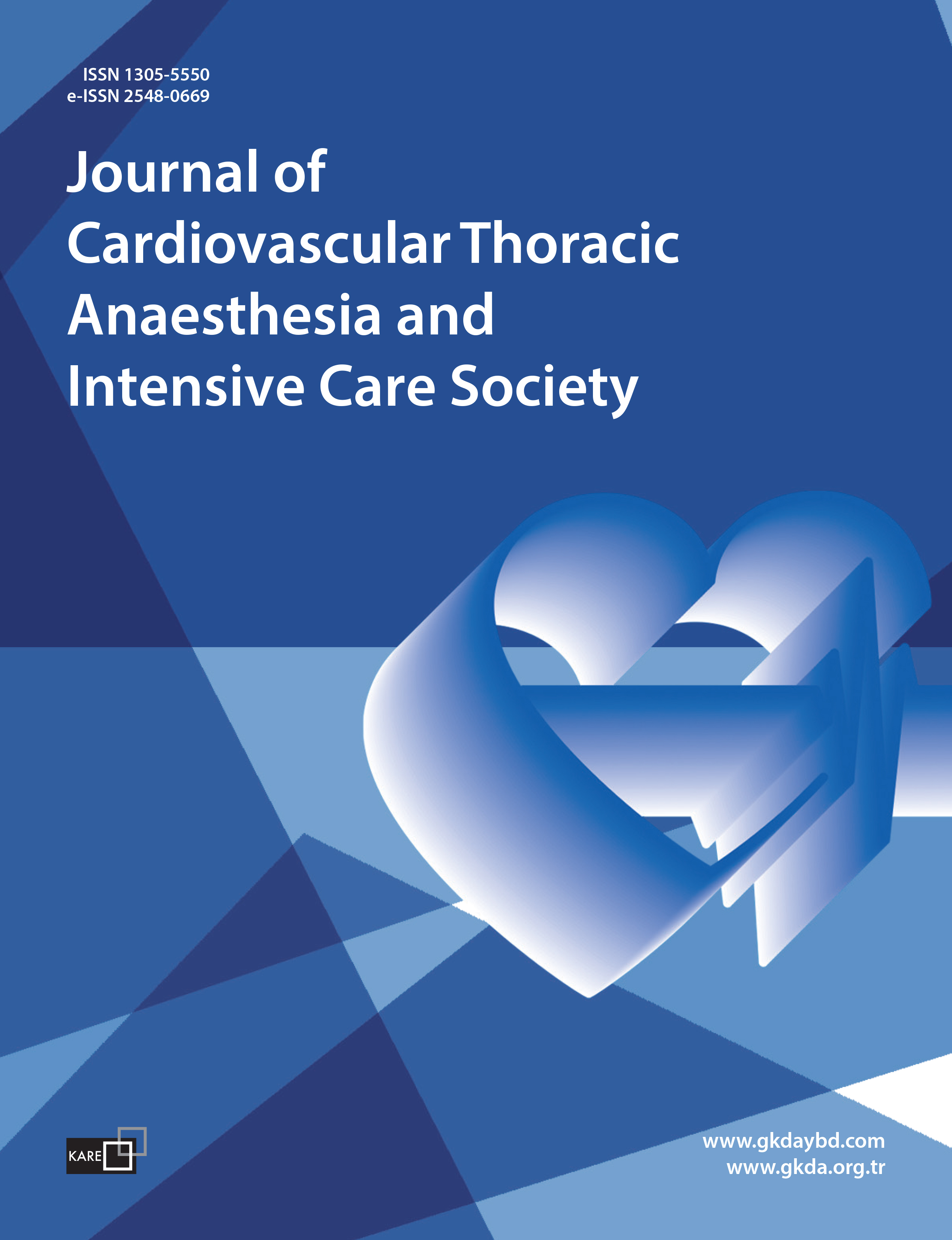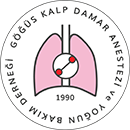

Volume: 28 Issue: 4 - 2022
| OTHER | |
| 1. | Frontmatters Pages I - XII (282 accesses) |
| RESEARCH ARTICLE | |
| 2. | Analysis of Clinical Results for Decision Making for Short- and Long-Term Ventricular Support in INTERMACS I and II Patients Sevinç Bayer Erdoğan, Osman Murat Baştopçu, Murat Acarel, Halit Er doi: 10.14744/GKDAD.2022.64935 Pages 295 - 299 (418 accesses) Objectives: The choice of ventricular mechanical support for end-stage patients presenting with Inter-Institutional Registry for Mechanical Assisted Circulatory Support (INTERMACS) profiles I and II is still controversial. In this study, we aimed to analyze the INTERMACS I and II patients who underwent extracorporeal membrane oxygenation (ECMO) or left ventricular assist device (LVAD) as a bridge to decision. Methods: Twenty-four patients were retrospectively analyzed as Group 1: ECMO and Group 2: LVAD implanted due to critical clinical status at INTERMACS profile I and II during 2014 and 2022. Results: Mechanical support was ECMO in 9 patients and LVAD in 15 patients. The baseline characteristics of patients receiving ECMO and LVAD were not different in terms of comorbidities or cardiac parameters. Total mortality was 17 (70.8%) in INTERMACS I and II patients. Mortality did not differ between patients with ECMO and directly implanted LVAD. (p=0.669). Conclusion: As both types of mechanical support will be highly mortal, in multiorgan failure with severe metabolic disorder, ECMO shall be the first choice. On the other hand, LVAD can be the therapy of choice when there is no organ failure or metabolic disorder. Additionally, the availability of organ transplantation should be considered in final decision making on a patient basis. |
| 3. | Differential Diagnosis of Postoperative Hyperlactatemia Halim Ulugöl, Melis Tosun, Meltem Güner Can, Uğur Aksu, Fevzi Toraman doi: 10.14744/GKDAD.2022.26234 Pages 300 - 305 (469 accesses) Objectives: It is important to make the differential diagnosis of post-operative hyperlactatemia and to treat it early to prevent complications in coronary artery bypass grafting (CABG). In our study, we aimed to use near-infrared spectroscopy (NIRS), a non-invasive monitoring method, to make this distinction. Methods: Sixty patients who were planned for CABG and whose ethics committee and patient consent were obtained were included in the study. Age, weight, body surface area, gender, body temperature, intra-operative and post-operative hemodynamic parameters, lactate and other arterial blood gas values, cardiopulmonary bypass and aortic cross clamp time, urine output, blood product, and inotropic agent use were recorded. Regional cerebral oxygen saturation (rSO2) was continuously monitored through a sensor and device placed on the patients fore-head. The post-operative period was divided into 10-time points. Values were recorded as T1 admission to the intensive care unit (ICU), T2-T9 ICU follow-ups with 1-h intervals, respectively, and ICU exit at T10. Results: Heart rate, mean arterial pressure, body temperature, pH, pCO2, pO2, Hct at 1, 2, 3, 4, 5, 6, 7, and 8 h after admission to the ICU when was compared with baseline time point (T1), no significant change was detected (p>0.050). We found that post-operative blood lactate level increased from T1 to T9 period, but rSO2 did not show a parallel change in this process (p>0.05). Conclusion: NIRS monitoring is a useful non-invasive method in the differential diagnosis of early hyperlactatemia after CABG. Therefore, we recommend NIRS monitoring in the post-operative period in clinical practice to ensure patient safety. |
| 4. | Evaluation of the Effect of Low Cardiac Output Syndrome on Intestinal Flow After Arcus Aorta Surgery in Newborns Dilek Yavuzcan Öztürk, Halise Zeynep Genç doi: 10.14744/GKDAD.2022.89106 Pages 306 - 311 (417 accesses) Objectives: Dynamic changes during arch surgery in newborns may cause ischemia and tissue damage as a result of decreased blood flow in critical organs. In this study, it was aimed to investigate the changes in intestinal blood flow with Doppler ultrasonography (USG) in the presence of low cardiac output in the early period in newborns who had surgical intervention in the aortic arch. Methods: The study was carried out between August 1, 2021, and August 1, 2022, in newborns younger than 30 days of age at the time of the operation and who had undergone arch reconstruction surgery. The presence of low cardiac output in the cases was determined by low cardiac output syndrome (LCOS) scoring. Initial, 24th and 48th h intestinal flows of the cases with and without LCOS were calculated by Doppler USG. The celiac artery (TC) was used as the measurement site. Peak systolic velocity (PSV), mean systolic velocity (MV), and end-diastolic velocity (EDV) values, resistance index (RI) and pulsatility index (PI) findings of each case were evaluated statistically. Results: There were 24 cases during the study period. 70% of the cases were male. The median age at the time of surgery was 15 days (IQR 1218 days) and median weight was 3.2 kg (IQR 2.93.4). LCOS was detected in 25% of cases (n=6). Initial median PSV (72 vs. 76 cm/sec), EDV (27 vs. 30 cm/sec), MV (24 vs. 26), RI (0.79 vs. 0.75), and median PI (1.60 vs. 1.75) values of cases with and without LCOS were similar to each other. There was a significant difference between the values of 24th hour median PSV (55 vs. 66 cm/sec), EDV (21 vs. 27 cm/sec), median MV (18 vs.24), median RI (0.84 vs. 0.76), and median PI (1.65 vs. 1.78) of cases with and without LCOS (p<0.05). 48th h median PSV (75 vs. 80 cm/sec), EDV (30 vs. 32 cm/sec), MV (25 vs. 26), median RI (0.80 vs. 0.74), and median PI (1.55 vs. 1.65) values of cases with and without LCOS were similar. Conclusion: Changes affecting intestinal blood flow were detected in Doppler USG at the 24th h in newborns who developed LCOS after arcus surgery. |
| 5. | Neuropathic Pain After Thoracotomy: Risk Factors and Incidence Emel Gündüz, Hakan Keskin doi: 10.14744/GKDAD.2022.84855 Pages 312 - 317 (520 accesses) Objectives: Chronic persistent post-operative pain, which persists for about 2 months or longer in 2575% of patients who underwent thoracotomy operation, adversely affects patients lives for years. In this study, we aimed to elucidate the etiology and incidence of neuropathic pain in patients undergoing thoracotomy. Methods: Patients over the age of 18, who applied to the department of thoracic surgery with different diagnoses between 2017 and 2019 and underwent thoracotomy or video-assisted thoracoscopic surgery, and whose operation was performed 3 months before or more were asked to fill the previously prepared Neuropathic Pain After Thoracotomy Incidence and Pain Evaluation of Risk Factors form, during their polyclinic controls. In addition to demographic information such as age, gender, height, weight, body mass index, comorbidities, pre-operative hypnotic use, and neuropathic pain scores were also determined according to the LANSS pain scale. Results: Of the 109 cases in which we evaluated the incidence and risk factors of neuropathic pain after thoracotomy, LANSS pain score was higher in females (p=0.03). The LANSS pain score was statistically significantly higher when viewed according to the smoking per pack/year. Conclusion: If a thoracotomy is to be performed in female patients with heavy smoking, permanent thoracotomy pain should be prescribed, attention should be paid to the severity of the pain, and if necessary, individual analgesic methods should be determined. |
| 6. | Determination of EkoSonic Endovascular System Treatment According to Patient Characteristics in High-risk Pulmonary Embolism Patients Ismail Selçuk, Nehir Selçuk, Mustafa Şimşek, Şebnem Albeyoğlu, Ahmet Turan Yılmaz doi: 10.14744/GKDAD.2022.26986 Pages 318 - 325 (566 accesses) Objectives: Pulmonary embolism (PE) is the third most common cause of cardiovascular death. The EkoSonic Endovascular System is one of the treatments for thrombus. In this study, it was aimed to investigate the results of ECOS treatment and the effects of personal characteristics such as age, gender, and clinical history on the effectiveness and safety of treatment in patients with high or moderately high-risk PE. Methods: In this study, 51 patients who underwent ECOS with the diagnosis of medium-high-risk PE were analyzed retrospectively. Arterial blood gas oxygen saturation, partial oxygen pressure (PaO2) val-ues, RV diameters, pulmonary arterial pressure (PAPs), and tricuspid regurgitation in echocardiography and Qanadli Score in computed tomography were recorded in all patients before and after the procedure. In addition, PE and deep vein thrombosis localization, complete blood count, hemoglobin, hematocrit, platelet count, urea, creatinine values, minor and major bleeding, recurrent venous thromboem-bolism, and presence of complications were evaluated. All the data obtained were compared in male and female groups, in the over 65 age group and in groups classified according to the history of the underlying disease. Results: In all patients, the mean of saturation and PaO2 after the procedure was higher than before the procedure, the averages of hemoglobin, hematocrit, creatine, right ventricular (RV) diameter, PAP, and Qanad value were found to be lower than before the procedure (p<0.05). The RV diameter difference before and after the procedure was found to be higher in patients over 65 years of age than in patients under 65 years of age (p<0.05). Considering the gender distribution of ten patients with complications, 1 (10%) of the patients were male and 9 (90%) were female. Conclusion: This study shows that ECOS is an effective treatment option in patients with high-risk PE. |
| 7. | Evaluation of Cerebral Oxygenation During One-lung Ventilation in Diabetic Patients Undergoing Lung Resection: A Prospective and Observational Study Selda Şen, Salih Çokpınar, Imran Kurt Ömürlü, Sinem Sarı, Simge Alkut Kurum, Serdar Şen doi: 10.14744/GKDAD.2022.49358 Pages 326 - 333 (471 accesses) Objectives: Cerebral oxygenation may decrease due to hypoxia during one lung ventilation (OLV) in thoracic surgery. Diabetic patients are at increased risk of cerebral and renal damage after major surgery due to microangiopathy. The primer aim of our study is to evaluate whether cerebral oxygenation is affected during OLV with near infrared spectroscopy (NIRS) and arterial/central venous oxygen saturation of the central venous blood (ScvO2) blood gases in diabetic patients. The secondary aim of our study is to investigate whether there is a relationship between cerebral oxygenation and changes in renal functions in diabetic patients. Methods: Diabetic patients underwent lung resection between 2018 and 2021 were included in our prospective, case-controlled study. Regional oxygen saturation (rSO2) and hemodynamic parameters of the cases were recorded every 15 min from the pre-operative period to extubation. Central venous and arterial blood gas samples were taken from the patients during single lung ventilation and double lumen ventilation. They were recorded simultaneously with rSO2 and hemodynamic data. Pre-, post-operative creatinine values were checked. Results: Fifty-two patients were included in the study. It was completed with 19 diabetic and 22 normal blood sugar patients. rSO2 decreased according to baseline measurements in both groups at 30 min during OLV. While rSO2 values were lower in OLV 60 min and throughout the DLV in diabetic patients, it was around basal values in control group. Hemodynamic data and ScvO2 values were similar. A correlation was observed be-tween rSO2 values and creatinine values during OLV in diabetic patients. Conclusion: In our study, it was shown that cerebral oxygen values mea-sured by NIRS during OLV in lung surgery decreased more in diabetic patients than control group, but were not within the pathological limits. |
| 8. | Early and Late Findings and Treatments of Foreign Body Aspirations in Adults Mehmet Değirmenci doi: 10.14744/GKDAD.2022.54715 Pages 334 - 338 (560 accesses) Objectives: This study aims to determine the early and late treatment, morbidity, and mortality of foreign body aspiration (FBA). Methods: The retrospectively analyzed FBA cases admitted to the thoracic surgery clinic. The patients were evaluated clinically and radiologically. Fiber optic or rigid bronchoscopy was used for diagnosis and treatment. Thoracotomy was performed when necessary. Results: Of the 23 patients evaluated, 15 (65.21%) were male. The mean age was 38.30±16.60. Of the patients, 17 (73.91%) were admitted early, and 6 (26.09%) in the late period. Twelve (52.17%) patients had risk factors. Risk factors were higher in patients admitted later than in the early period (p=0.014). Medical treatment was sufficient in four patients. The foreign body (FB) was removed by fiber optic bronchoscopy in three patients, rigid bronchoscopy in ten patients, and thoracotomy in six patients. The thoracotomy rate in patients who came to the hospital late was higher than in those who came in the early period (p=0.001). The most common localization was the trachea and right bronchial system, and the most common FB was a pin. Complications developed in 7 (30.43%) patients. The complication rate was higher in patients admitted in the late period (p<0.001). No mortality was observed. Conclusion: Unnoticed foreign bodies in adults can lead to severe complications in the long term. Relatives of patients with risk factors should be careful about FBA and immediately apply to a health institution in case of suspicion of aspiration. |
| 9. | Surgical Treatment Methods and Results in Complicated Pulmonary Hydatid Cyst Fatoş Kozanlı, Mehmet Değirmenci, Ahmet Karslıgil doi: 10.14744/GKDAD.2022.04875 Pages 339 - 344 (468 accesses) Objectives: Pulmonary cystic hydatidosis (PCH) is a parasitic infestation caused by Echinococcus granulosis. Despite all advanced diagnosis and treatment methods, morbidity is between 3.5 and 18% and mortality is between 0 and 2%. We aimed to contribute to the reduction of mortality and morbidity by discussing the relationship between cyst rupture and pre-operative/post-operative complications and treatment methods in complicated pulmonary hydatid disease with the knowledge gained in the following years. Methods: The files of 101 patients were evaluated retrospectively. Patients age, gender, number of hydatid diseases, rupture, symptoms, pre-operative and post-operative complications, type of operation, length of hospital stay, follow-up periods, and mortality rates were analyzed. Results: The mean age was 39.2±18.2. There were pre-operative complications in 35 (34.6%) of the patients. Cyst rupture was detected in 54 (53.5%) of the cases. The presence of rupture was found to be highly correlated with pre-operative/post-operative complications, symptoms, preference for resection, and length of stay. The most common pre-operative complication was lung abscess in 18 (17.8%) cases. Post-operative complications were observed in 30 (29.7%) of the patients. No relapse was detected. Mortality occurred in 2 (1.9%) cases. Lobectomy was found to be associated with pre-operative complications. Complicated hydatid cysts were associated with high morbidity and prolonged hospital stay. Conclusion: The curative treatment of pulmonary hydatid disease is surgery. The need for major surgery is higher in complicated PCH. Cyst rupture is associated with pre-operative/post-operative complications. We hope that treating PCH before complications develop will reduce morbidity, length of hospital stay, and therefore the cost of treatment. |
| 10. | Evaluation of the Pandemic Management and Treatment Approaches of the Doctors in the COVID-19 Pandemic: An Online Cross-sectional Study from Türkiye Sinem Bayrakçı, Zehra Hatipoğlu, Nazire Ateş Ayhan, Nursel Sürmelioğlu, Dilek Özcengiz doi: 10.14744/GKDAD.2022.87369 Pages 345 - 356 (518 accesses) Objectives: This study was planned to evaluate the perspectives, experiences, and methods followed by physicians on the treatment and management of COVID-19 infection, which affects the whole world. Methods: In this study, in which physicians were included in the study, a questionnaire consisting of 21 questions was conducted in the electronic environment. The questionnaire questions included the treatment methods applied by the physicians during the COVID-19 pandemic, the guidelines they followed and their own clinical experiences. Results: Our study was conducted with a total of 200 physicians, 72 (36.0%) men and 128 (64.0%) women. The mean age of the physicians was 36.54±7.40 years. In the management and treatment of COVID-19 patients, 78.5% of the participants preferred to use the Ministry of Healths COVID-19 Outbreak Management and Study Guide (MHCOMSG) and 60.5% preferred to use the current international guidelines. In the oxygen support management of hypoxemic patients, 53.5% of the participants preferred to follow their personal experience and experience, 52.5% of them preferred to follow the MHCOMSG, 51% of them preferred to follow the current international guidelines. There is a statistically significant relationship between the duration of professional experience, the institution where the employee is working and treatment management preferences. Conclusion: During the COVID-19 pandemic process, physicians preferred to follow the MHCOMSG in treatment and patient management. It is important for health-care professionals to follow new developments closely and to make updates on COVID-19 published online by official government health officials in terms of health workers preferences in accessing information. |
| 11. | Can Pneumothorax Developing in COVID-19 Patients be a Mortality Marker? Mesut Öterkuş, Leman Acun Delen, Umut Sabri Kasapoğlu doi: 10.14744/GKDAD.2021.50455 Pages 357 - 361 (386 accesses) Objectives: The purpose of this study is to investigate the effects of pneumothorax (PX), a rare complication of COVID-19, on mortality. Methods: All patients admitted to our hospital with the diagnosis of COVID-19 were screened, and patients who developed PX were included in the study. Patient demographics data, number of days of hospitalization for comorbidities, day and duration of thorax tube insertion, and laboratory findings during hospitalization were recorded by scanning the hospital automation system and patient records. Results: For our study, 7485 patients hospitalized with the diagno-sis of COVID-19 were screened in intensive care unit. PX was detected in 32 (0.296%) of the patients. About 59.4% of these patients included in the study were male. DM was the most common comorbid condition at 56.3%. In these patients, the mortality rate was found to be 90.6%. Conclusion: The data obtained indicate that PX, a COVID-19 complication, leads to a serious increase in mortality. We believe that using protective ventilation methods to avoid the development of pneumotarax will help to reduce mortality. |
| CASE REPORT | |
| 12. | A Rare Complication After Central Venous Catheterization: Catheter Rupture Dilek Çetinkaya, Mehmet Mutlu, Aykut Şahin doi: 10.14744/GKDAD.2022.01328 Pages 362 - 364 (693 accesses) Central venous catheterization is a widely used venous vascular access intervention and is often used in patients receiving treatment in intensive care units, in various surgeries and for hemodialysis. For this, the vena jugularis interna, femoral vein and subclavian vein, and more rarely the vena jugularis externa, basilic, and cephalic veins are used. Complications are encountered in central venous catheterization applications. Morbidity and mortality can be significantly reduced by rapid detection and treatment of complications in the early period. In this article, a patient with renal failure who was inserted into the right vena jugularis interna ruptured and migrated to the inferior venacava is presented. |
| 13. | Cold Agglutinin Detected in the Intraoperative Period: A Case of Coronary Bypass Ayşegül Özgök, Aslı Demir, Eda Balcı doi: 10.14744/GKDAD.2022.58561 Pages 365 - 367 (565 accesses) Cold agglutinin disease(CAD) is an autoimmune disease that occurs against erythrocyte antigens. It is usually idiopathic, but some infections can also be a trigger. CAD becomes active in the peripheral circulation at lower temperatures more easily when exposed to cold, causing hemolysis or agglutination. In this article, the management of a coronary bypass case with CA formation in intraoperative period is presented. A 46-year-old diabetic and hypertensive male patient had COVID-19 2 months ago. Cardio-pulmonary bypass(CPB) was initiated with adequate heparinization, and the patient was cooled to 32°C. It was noticed that there were clots in the cardioplegia delivery line(+1°C). Agglutinations were observed in the autologous blood of the patient whose ACT values were normal. After CPB, the operation was completed without any problems and the patient was discharged on the 5th day with recovery. A diagnosis of CAD was made with the results of peripheral smear and immunologic tests. Determination of antibody concentration and thermal amplitude in the preoperative period in patients with CAD is very important. While preparing such patients for surgery, heating of room, patient, fluids, planning of normothermic CPB, and using warm cardioplegia are required. The relationship between CAD and COVID has started to take place in the literature. The patient we presented had a COVID 2 months ago, cold agglutinin may have been induced by COVID or may have arisen idiopathic. Considering that many people may have had a COVID nowadays, care should be taken especially in the perioperative period of cardiac surgery. |
| 14. | Anesthesia Management in a Pediatric Patient with Pulmonary Hydatid Cyst Ebru Emre Demirel, Özlem Turhan, Başak Erginel, Naila Mustafayeva, Meltem Savran Karadeniz doi: 10.14744/GKDAD.2022.43043 Pages 368 - 372 (660 accesses) Hydatid cyst is a parasitic disease caused by Echinococcus granulosus and transmitted to humans mostly through canine feces. Although it can settle in every organ in the body, the most frequently involved organ in children is the lung. As well as being asymptomatic, pulmonary hydatid cyst may cause complaints such as chest pain, cough, shortness of breath, and hemoptysis. Hydatid cyst treatment is primarily surgical. With the rupture of the cyst during the operation, anaphylactic shock and even death can be seen. In case of sudden onset of tachycardia and decrease in mean arterial pressure during hydatid cyst operation, the possibility of anaphylaxis should be kept in mind after excluding other possibilities. We think that keeping in mind that anaphylaxis may develop in patients who will undergo surgery for hydatid cyst and being prepared for this will have a significant positive effect on mortality and morbidity. In this case report, we aimed to present our anesthesia experience of anaphylactic reaction following cyst rupture during surgical excision of lung hydatid cyst. |
| 15. | Combined use of Fast Track Anesthesia and Minimal Extracorporeal Circulatory Systems in an Advanced Age and Comorbid Patient Undergoing Coronary Artery Bypass Surgery Selma Fiş Topaloğlu, Melek Eroğlu, Ali Kemal Arslan, Engin Ertürk doi: 10.14744/GKDAD.2022.81488 Pages 373 - 377 (408 accesses) The risk of mortality and morbidity is high in patients with advanced age and additional systemic diseases who will undergo coronary artery bypass surgery. For this reason, the chosen anesthesia method and surgical approach gain importance. With the Fast track cardiac anesthesia (FTKA) protocol, the length of stay in hospitals and intensive care units is shortened, thus reducing the risk of mortality and morbidity in elderly and comorbid patients. In recent years, the use of Minimal Extracorporeal Circulatory Systems (MECC) has become widespread by modifying conventional extracorporeal circulatory systems in open heart surgery. With MECC, the systemic inflammatory response seen in the conventional system is reduced. In this article, we present the combination of FTCA protocol and MECC use, which we successfully applied in an 81-year-old patient with comorbidities. Our patient underwent triple coronary artery bypass surgery and was discharged on the 6th post-operative day with full recovery. We believe that the risks can be reduced and successful results are obtained with the anesthesia method (FTKA) and surgical approach (MECC) chosen in patients with advanced age and additional systemic diseases who will undergo coronary artery bypass surgery. |

















